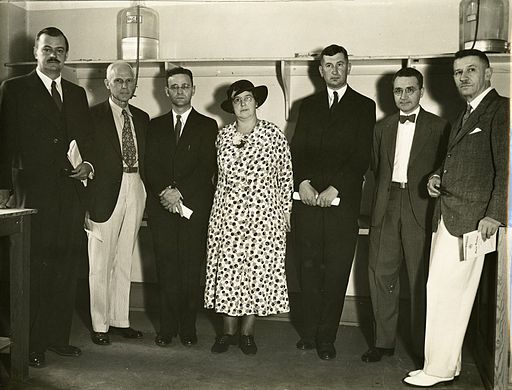Gioacchino Failla was an Italian-American physicist who served as a consultant at the University of Chicago’s Metallurgical Laboratory (“Met Lab”) during the Manhattan Project.
During World War II, Failla (second from right in below photograph) became a consultant to the Manhattan Engineering District and the Met Lab. The concept of “health physics” emerged at the Met Lab. It was used to denote the difference between physicists involved in radiation protection from theoretical physicists focused on physical science.
Failla began to use the term in the early 1940s. Mathematician Walter Stephen Snyder referred to Failla as ‘one of the earliest and greatest health physicists.’ During the summers, he worked at the Marine Biological Laboratory in Woods Hole, Massachusetts. At this laboratory, he installed a dual tube high-intensity x-ray unit.
Early Years
On July 19, 1891, Gioacchino Failla was born in Sicily, Italy. He immigrated to the United States when he was fifteen years old. Failla graduated from Stuyvesant High School and received a Pulitzer Scholarship to attend Columbia University.
He graduated from Columbia with a B.S. in Electrical Engineering in 1915 and a master’s degree in physics in 1917. To help pay for his graduate studies, Failla began working at New York’s Memorial Hospital in 1915.
He became an American citizen in 1916. During World War I, he served as an assistant to the scientific attache of the American Embassy in Rome, Italy.
For his Ph.D., he studied and earned his degree in 1923 at the Sorbonne in Paris, France. Following his time in Paris where he worked with Marie Curie, Failla published protocols and outlined equipment designed to help radiotherapists to accurately deliver radiation doses to their patients.
In 1925, Failla married Marie Muller, an art student and secretary at Memorial Hospital. During this period, he also founded the International Commission on Radiation Units and Measurements (ICRU) and the Radiation Research Society. He served as the President of the Radiation Research Society.
In 1936, his wife died from a streptococcal infection, which left Failla as a widower and single father of two young daughters. He was a devoted and loving father, who was attentive of his daughters’ needs and supported their higher education studies and professional pursuits.
In 1942, he left Memorial Hospital for Columbia University, where he became a professor of radiology in the Physics Department and Director of the Radiological Research Laboratory at the College of Physicians and Surgeons.
Later Years
In 1945, the Radiological Society of North America awarded Failla with its gold medal. Besides working at Columbia, he also served as a consultant to the Public Health Services, Veterans Administration, Argonne National Laboratory and Los Alamos Scientific Laboratories.
At the same time, Failla became the Chief of the Biophysics Branch in the Division of Biology of the Atomic Energy Commission. From 1946 to 1957, he was an executive of the National Committee on Radiation Protection. On January 22, 1949, he married Patricia McClement, who he met when she was a pre-doctoral student at another Columbia physics laboratory.
After retiring from Columbia in 1960, he became a Senior Scientist Emeritus in the Radiological Physics Division of Argonne National Laboratory. His wife became an associate scientist at Argonne. In November 1961, he was inducted as an honorary member of the Radiological Society of North America.
On December 15, 1961, Gioacchino Failla died in a car accident in Chicago, Illinois.
Scientific Contributions
At Memorial Hospital, Failla developed the first research program focused on the medical applications of radiation. In 1921, he proposed that radiation doses should be expressed as the amount of radiation energy absorbed. Failla made the first dose estimate in radium therapy in terms of microcalories per cubic centimeter of tissue.
In 1922, after receiving an X-ray unit, he constructed the first human phantom in the United States. He used the human phantom to determine the effects of filtration and distance on X-ray fields in the human body.
At Columbia, he contributed to the scientific and medical communities’ understanding of radiation mutagenesis and induction of cancer by radiation.
For more information about Gioacchino Failla, please see the following references:





